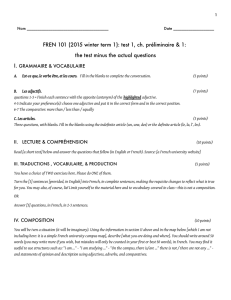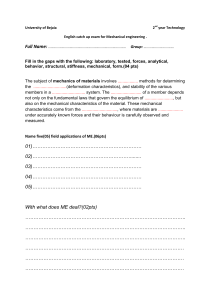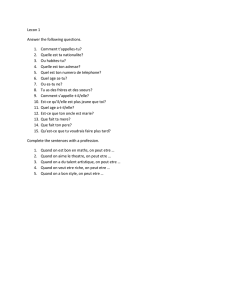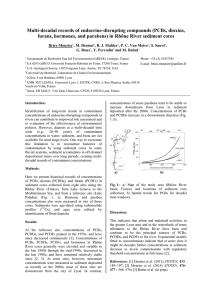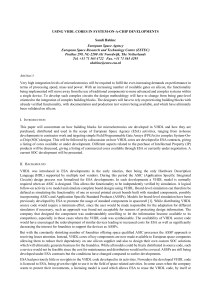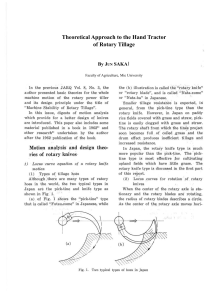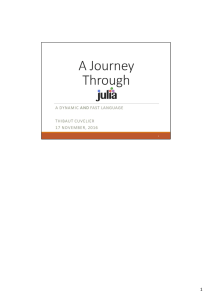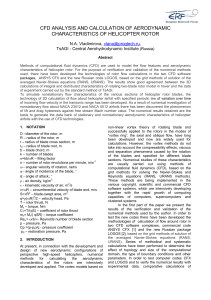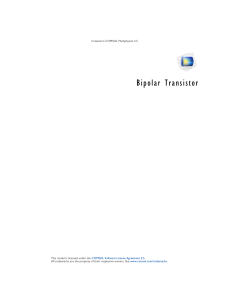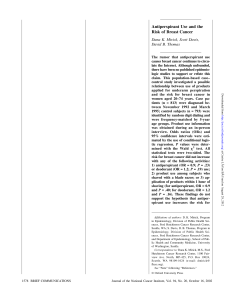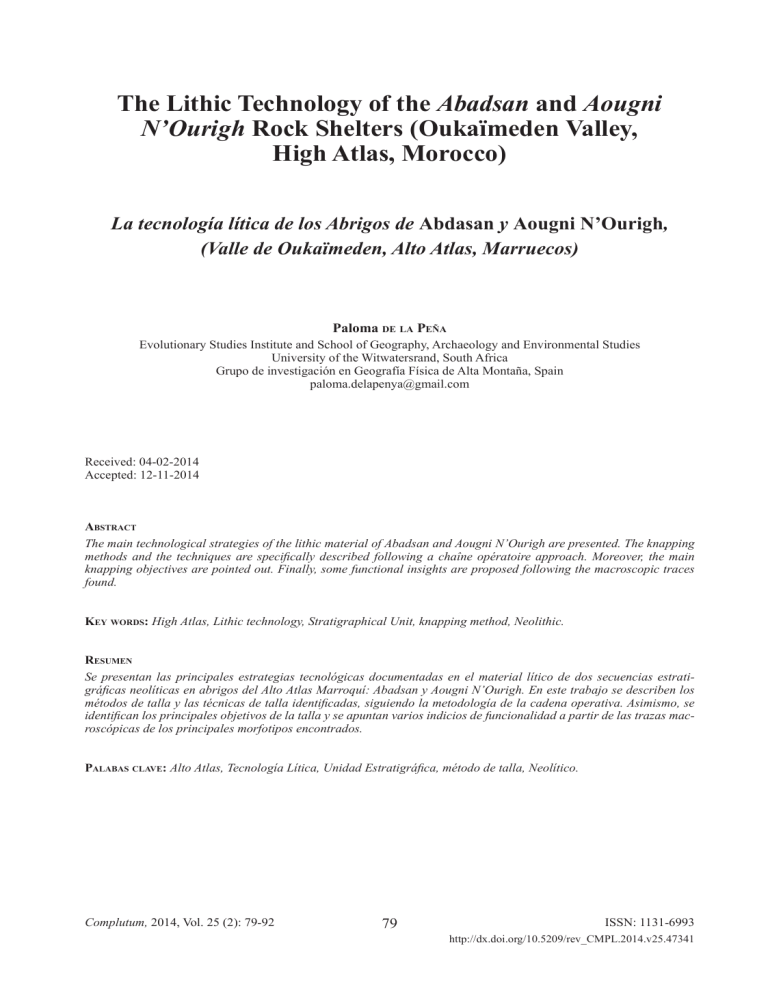
The Lithic Technology of the Abadsan and Aougni N’Ourigh Rock Shelters (Oukaïmeden Valley, High Atlas, Morocco) La tecnología lítica de los Abrigos de Abdasan y Aougni N’Ourigh, (Valle de Oukaïmeden, Alto Atlas, Marruecos) Paloma de la Peña Evolutionary Studies Institute and School of Geography, Archaeology and Environmental Studies University of the Witwatersrand, South Africa Grupo de investigación en Geografía Física de Alta Montaña, Spain [email protected] Received: 04-02-2014 Accepted: 12-11-2014 Abstract The main technological strategies of the lithic material of Abadsan and Aougni N’Ourigh are presented. The knapping methods and the techniques are specifically described following a chaîne opératoire approach. Moreover, the main knapping objectives are pointed out. Finally, some functional insights are proposed following the macroscopic traces found. Key words: High Atlas, Lithic technology, Stratigraphical Unit, knapping method, Neolithic. Resumen Se presentan las principales estrategias tecnológicas documentadas en el material lítico de dos secuencias estratigráficas neolíticas en abrigos del Alto Atlas Marroquí: Abadsan y Aougni N’Ourigh. En este trabajo se describen los métodos de talla y las técnicas de talla identificadas, siguiendo la metodología de la cadena operativa. Asimismo, se identifican los principales objetivos de la talla y se apuntan varios indicios de funcionalidad a partir de las trazas macroscópicas de los principales morfotipos encontrados. Palabas clave: Alto Atlas, Tecnología Lítica, Unidad Estratigráfica, método de talla, Neolítico. Complutum, 2014, Vol. 25 (2): 79-92 79 ISSN: 1131-6993 http://dx.doi.org/10.5209/rev_CMPL.2014.v25.47341 Paloma de la Peña The Lithic Technology of the Abadsan and Aougni N’Ourigh... Introduction Aougni N’Ourigh and Abadsan Rock shelters. The first one is a completely unreleased archaeological sequence, while the second one is a wellknown rock art site with an associated stratigraphical sequence. It must be highlighted that previous research has been undertaken in this area of Morocco, mainly on rock art (Salih et al., 1998; Searight 2004, 2013, for the most recent works) and lithic typology (Rodrigue, 1985, 1990). These new analyses offer a more complete view of this particular period in this rich archaeological region. The study of the Neolithic in North-West Africa is still under discussion. Two major regions have been the object of recent research: the Moroccan area of the Strait of Gibraltar (e.g. Kaf That elGhar and Kaf Boussaria, near Tétouan) (Daugas, 2002; Ballouche et al., 2012) and the eastern area of Morocco, the Moroccan Rif (Linstädter, 2008; Linstädter et al., 2012). Lithic technology is one of the main sources of material culture manifestation of Neolithic populations. As Manen et al. (2007) proposed, it seems that new techniques, such as heat treatment and pressure flaking were spread during the Neolithic. Therefore, the lithic industry must play a key role in the definition of this period, as well as the techno-economic implications of its development. In this paper I present the lithic strategies developed in two sites of the Moroccan Atlas: the Methodology: lithic industry analysis I followed the same methodological approach for the study of these two sites. First, I selected and analysed all the cores and trimming by-products. Secondly, I studied the debitage, to add to the impressions gathered from knapping offered by the cores and trimming by-products. I also analysed blanks that displayed evidence for knapping accidents, because these kinds of pieces are usually highly informative. Finally, I analysed the formal tools and retouched pieces, which are usually considered the main knapping objectives. Cores were analysed using a combination of metrical and technological (qualitative) attributes. Most of the qualitative variables for the study of cores come from the Pelegrin methodological proposal for Chatelperronian cores (see Pelegrin, 1995). Notwithstanding my technological approach, a general classification of the core type is presented, based on the reduction sequence performed. I have selected broad categories for core morphology and method of reduction such as: prismatic core, multifacial core, core on flake, bipolar core, etc. For the trimming products analysis I followed a very similar approach. The types of trimming products are clearly related to blade-bladelet production. For the debitage analysis I measured all the completed blanks above 10mm. In the case of blade/bladelets blanks I recorded different qualitative and quantitative characteristics, in order to facilitate the comprehension of the knapping methods and the techniques. The blade and bladelet distinction was made tipometrically (Tixier, 1963). Thus, elongated pieces with parallel ridges under 12 mm breadth were considered bladelets. For the formal tools we used broad typological categories, but once again we took into account all the technological characteristics of the retouch. Fig. 1. Different examples of Aougni N’Ourigh cores. All the pieces are in flint except A which is in sandstone. A. Core for flakes. B. Discoidal core. C, D, E, F, G, H and I cores made from small nodules. All of them with unipolar extractions, except D and E which present negatives from two opposed striking platforms. H probably was converted into a bipolar core, on the bottom a blunting edge is shown. All the scales are 1cm. Complutum, 2014, Vol. 25 (2): 79-92 80 The Lithic Technology of the Abadsan and Aougni N’Ourigh... Technological categories/ Stratigraphical unit Paloma de la Peña 1301 1302 1303 1305 1306 1309 1310 1311 1312 1313 1320 1321 1322 1324 1325 1326 Total % 4 27 60 29 48 5 293 11.2 22 25 49 37 46 12 485 18.5 10 12 21 18 19 7 134 5.1 22 7 12 22 11 24 2 142 5.4 11 4 4 11 11 1 89 3.4 27 1 100 201 26 108 40 1045 39.9 1 44 2 7 23 1 2 9 31 Flake fragments 125 33 21 26 1 8 54 24 Blade/bladelets 15 5 3 7 4 5 7 Blade/bladelets fragments 16 7 4 9 1 5 Splinters 20 4 4 7 1 11 1 3 1 94 33 152 55 23 Flakes Splinter fragments Chips 17 1 1 23 33 1 4 9 3 7 23 10 4 3 2 1 1 2 3 3 1 4 3 Cores Trimming products Formal tools Total 2 1 157 23 Chunks 1 7 5 7 5 1 3 8 45 21 16 14 3 14 16 472 104 99 190 53 264 182 2 2 4 2 3 85 3.2 23 0.9 63 2.4 1 3 11 4 6 10 10 30 24 22 4 229 8.7 82 203 431 160 295 72 2615 100 Table 1. Technological categories by stratigraphic unit from the Aougni N’Ourigh site. Core Types Prismatic core (one striking platform) 1301 1302 1303 1305 1306 1309 1310 1311 1312 1313 1320 1321 1322 1324 1325 1326 1 1 Prismatic core (2 opposed striking platforms) 1 Discoidal core 1 Core fragment 4 1 1 2 3 1 1 1 1 1 ∑ 9 8,3333 1 5 4,6296 1 3 2,7778 8 7,4074 1 1 0,9259 1 1 0,9259 Core on flake Bipolar core 1 17 23 % 1 2 Tested core/ nodule Blade core recycled into flake core ∑ 11 15 6 8 5 6 0 1 1 4 5 1 0,9259 8 10 1 1 0 4 5 5 8 7 10 6 7 5 9 0 80 74,074 108 100 Table 2. Type of cores by stratigraphic unit from the Aougni N’Ourigh site. Aougni N’Ourigh ed in the two surveys is around seven square meters. A small wall, which closes the space around the big block (shelter) appeared during the excavations, as well as small accumulations of stone structures (See above Chapter 2.1). In short, it appears to be a small hut just over four or five square meters, which corresponds well with a seasonal shelter. Given that this site is a high mountain site, there are interesting implications from the point of view of how space was used in the Neolithic. On the other hand, most of the post-depositional processes must be related to periglacial conditions. The site The site was discovered in 2010 in the prospection survey of the ARPA project. It has been the object of two archaeological excavations (in 2010 and 2011). The site consists of a small stone enclosure. In the northeastern part of this natural stone enclosure a larger rock is notoriously more prominent. This rock probably served as a small rock shelter in the past. The deposit is around ten square meters and the area excavat- 81 Complutum, 2014, Vol. 25 (2): 79-92 Paloma de la Peña The Lithic Technology of the Abadsan and Aougni N’Ourigh... The lithic technology: general insights Aougni N’Ourigh has a total of 2615 pieces, which is quite a large sample in view of the small surface area of the site. Sixteen stratigraphic units have been distinguished, with unequal representation of artefacts (table 1). We have excluded the surface findings from this study due to the lack of stratigraphic references and because they might come from earlier periods. The lithic material is highly coherent and in an excellent state of preservation. Flint constitutes the only rock knapped at the site, although some opportunistic cores in sandstone have also been found. The material shows the complete chaîne opératoire, from acquisition to use (formal tools) and even recycling strategies. However, there are some artefacts that were probably brought already knapped to the site (see below). Fig. 2. Histogram with size dispersions of bladelets, flakes and bipolar blanks from the Aougni N’Ourigh site. Knapping methods Different reduction sequences are documented at the site; judging from the quantity of cores and trimming and/or maintenance by-products, it is obvious that this loci served as a knapping place or small workshop, among other possibilities. The presence of a sandstone hammer should also be highlighted in this regard. The main knapping methods documented at the site are: of the core is exploited as the knapping surface, starting the knapping from the narrow part of the core with an elongated cortical blade. These types of cores are well represented in the collection (see table 2 and fig. 1). Most of these cores have unipolar extractions. However, sometimes an opposed platform was used in the last core reduction phase to obtain the last few bladelets. Most of the blade and bladelet samples come from these cores and only a small percentage of blades, with breadths over 20mm, seem imported into the site. Therefore, there is an obvious continuum in the blade to bladelet Laminar methods, in order to obtain blades and bladelets. This type of knapping is usually obtained from nodules around 6 to 10cm in length. First, a flake is obtained as a striking platform. Secondly, the longest side Trimming product/ stratigraphical unit Tablet Semitablet Semicrest Overshoot flake/blade Resharpening flake Discoidal flake to give convexity Cleaning flake (for knapping surface) Total 1301 4 1303 7 1305 1 1306 1309 1 1310 1 1311 1 1 1 1 3 1312 2 1320 1321 2 1322 6 1325 2 1326 Total % 27 50 1 1.8519 2 3.7037 1 3 1 10 18.519 2 1 4 6 7 5 0 2 1 2 3 8 1 1.8519 1 2 1 1 3 2 11 2 6 8 14.815 0 5 9.2593 54 100 Table 3. Maintenance and trimming by-products by stratigraphic unit from the Aougni N’Ourigh site. Complutum, 2014, Vol. 25 (2): 79-92 82 The Lithic Technology of the Abadsan and Aougni N’Ourigh... Paloma de la Peña Fig. 3. Blade and bladelet blanks from the Aougni N’Ourigh site. Scale 3cm. reduction sequence, as seen in the histogram in figure 2 where most of the blades and bladelets have a breadth of between 5 and 20mm. From a qualitative point of view, the first blanks obtained from these cores probably had a rectilinear profile and acquired a more carinated profile as the knapping continued (see fig.3) for the different characteristics and profiles of the blade/bladelet production). I have also found maintenance and/or trimming by-products related to blade technology (table 3). Tablets are one of the most common by-products (fig. 4). They are probably associated with the rejuvenation of the angle between the knapping surface and the striking platform. These types of maintenance by-products are often reconverted into bipolar cores (see below), probably because they are usually thick flakes. Semicrested flake-blades also appear, usually to correct knapping accidents. However, crested blades/bladelets are absent for this modality of knapping. Blanks that resemble semicrested blades were also detected. However, these appear to be removals that have eliminated the overhang of a core. These may be related to a change of direction during knapping. Plunging overshoot flake-blades are also abundant, which could be related to ´cleanings` of the knapping surface (fig. 4). However, sometimes they are just overshoot accidents, in which case they also provide information about the morphology and characteristics of the cores. Discoidal methods are documented by a great amount of débordant flakes and pseudolevallois points (fig. 5). Moreover, three discoidal cores have also been documented at the site (fig. 1 and table 2). Nevertheless, this type of knapping seems more occasional than laminar production. Finally, bipolar knapping is also well presented. Bipolar knapping is defined as a method in which the core is placed on an anvil and held with the bare hand. The rock is hit on the top, causing blanks to fly off the top and the edge that is in direct contact with the anvil (Crabtree, 1972). Therefore, bipolar cores have two opposed striking platforms (one from the direct percussion and the other from contact with the anvil). 83 Complutum, 2014, Vol. 25 (2): 79-92 Paloma de la Peña The Lithic Technology of the Abadsan and Aougni N’Ourigh... Fig. 4. On the left, different examples of tablets from Aougni N’Ourigh. On the right, different types of cleaning flakes and overshoot flake blades accidents which show the morphology of cores from Aougni N’Ourigh. Scale 3cm. Bipolar cores usually present quadrangular or rectangular shapes. Both the striking platform and the edge in contact with the anvil present a rectilinear delineation with much evidence of blunting and fissuring, and a striking platform-surface with a knapping angle close to 90 degrees (Mourre, 1996). The identification of this particular knapping method is based on a recently published experimental proposal (de la Peña , 2011) and previous work (Tixier, 1963; Hayden, 1980; Chauchat et al., 1985; Le Brun-Ricalens, 1989; Mourre, 1996, 2004; Mourre and Jarry dirs., 2011; Furestier, 2005; Guyodo and Marchand, 2005; Le Brun-Ricalens, 1989). Some characteristics of this specific knapping method are: (i) cores with two opposed edges and removals with splinter (écallée) retouch, (ii) supposedly complete cores that tend to present rectilinear shapes at the edges and have quadrangular-rectangular morphologies, (iii) the opposed edges are usually completely flat and blunt, (iv) the negatives and the positives of the removals have very marked waves (de la Peña, 2011). Most of the bipolar cores in Aougni N’Ourigh appear to be flakes and others thick blanks (as maintenance and trimming by-products) which were converted into cores through this Complutum, 2014, Vol. 25 (2): 79-92 strategy (fig. 6).Consequently, bipolar knapping should be seen as a recycling knapping method. The main knapping objectives were bipolar blanks without retouch, which are well represented among the debitage. Figure 7 shows the size dispersion (length/ breadth ratio) of completed blade/bladelets, flakes and bipolar blanks. As can be seen, there is an obvious overlap between flakes and bipolar blanks. The main difference between these categories was the thickness of the blanks, which in the case of bipolar blanks is strikingly thin (cf. figs. 2 and 7). This distinction might have functional implications which should be researched in future use-wear studies, such as the recent work of Gibaja et al. (2012). As regards the knapping techniques, it seems that most of the blade/bladelet production was obtained with a hard or soft mineral hammer (the latter, probably made from the sandstone in the surrounding area) (following Pelegrin, 2000). It appears that the final shaping of a blank for an arrow head was performed by applying pressure by hand. Finally, two blades with a very straight and parallel profile appear to indicate pressure for blade/bladelet production (see below). However, the absence of a platform in both pieces does not allow me to formulate a stamen more contrasted with more qualitative attributes. 84 The Lithic Technology of the Abadsan and Aougni N’Ourigh... Paloma de la Peña Fig. 6. Bipolar cores from the Aougni N’Ourigh site. normality test for length, breadth and thickness of all of the triangles and trapezes, as can be seen in table 5. The breadth followed a normal distribution, indicating that this narrow measurement was sought intentionally. The most likely activity that can be associated with them is as hunting tips and barbs, even if macroscopic use wear traces are not evident. Fig. 5. Typical flakes from a discoidal knapping method from Aougni N’Ourigh. Scale 3cm. Objective of knapping and formal tools The different knapping methods presented clearly indicate a strong focus on blade/bladelet production; nevertheless, flake production and bipolar knapping (as a recycling strategy) is also present. The main question is: what were the objectives of knapping? Judging by the knapping methods, it is evident that both laminar blanks and bipolar blanks and flakes were sought. Nevertheless, formal tools and retouched pieces are generally considered the main objectives of knapping (Pelegrin, 1995). Therefore, the second question that we must formulate is: what tool classes are present and which are the blanks for those tools? As can be seen in table 4, geometric tools, backed pieces and retouched flakes and blades constitute the three major groups of the formal tools (figs. 8 and 9). Although the blanks for the geometric pieces are usually blades, flakes have also been identified (fig. 8).No microburin technique has been documented, and the production of blanks to create geometric backed tools was probably through segmentation of blades. Many of these pieces present bifacial flat retouch (doble bisel). The main morphological shapes are triangles (the Cocina type must be highlighted among the morphotypes) but trapezes also appear. The narrow breadth of most of the geometric backed tools is striking, as they never exceed a centimetre (fig. 10A). I performed a Shapiro-Wilk Fig. 7. Length/Breadth ratio of blade/bladelets, flakes and bipolar blanks from the Aougni N’Ourigh site. 85 Complutum, 2014, Vol. 25 (2): 79-92 Paloma de la Peña The Lithic Technology of the Abadsan and Aougni N’Ourigh... 1301 1302 1303 1305 1306 1309 1310 1311 1312 1313 1320 1321 1322 1324 1325 1326 Total % Microlithic point Geometric (Triangles and trapezes) Truncation Burin End-scraper Backed fragment Backed blade Backed point Double backed blade Backed bladelet Truncated backed bladelet Double backed bladelet Notch Denticulate Arrow head Retouched flake (simple) Retouched blade (simple) Retouched blade (marginal) Retouched bladelet (simple) Retouched bladelet (marginal) Retouched splinter (simple) Piece with flat retouch Total 3 2 3 1 4 3 4 3 1 1 3 1 1 1 1 1 8 1 2 1 4 2,8 33 9 4 1 23,1 6,29 2,8 0,7 2 1,4 1 0,7 1 0,7 2 1,4 4 2,8 1 0,7 1 3 1 1 0,7 2,1 0,7 0,7 36 25,2 21 14,7 1 2 1,4 3 9 6,29 5 3,5 1 0,7 1 143 0,7 100 2 1 2 1 1 1 1 1 2 1 1 1 1 1 1 2 1 1 1 9 1 9 1 1 6 1 1 3 1 8 4 11 1 2 2 1 2 1 2 1 1 1 30 10 10 9 2 8 8 1 6 5 1 23 14 13 4 Table 4. Formal tools and retouched pieces from the Aougni N’Ourigh site. There is an evident lack of domestic tools (such as end-scrapers, burins, etc. table 4), which constitute a minority of the formal tools sample.These types of tasks were probably performed with the large numbers of blades that were not retouched. Notwithstanding the retouched tool distributions, I want to address the high frequency of pieces without retouch that exhibit macro-traces of use, such as the bipolar blanks and the large number of flakes and blades. Among the backed pieces there are double and single backed tools. Microlithic points are not abundant but present nonetheless. Finally, the group of retouched flakes and blades must be highlighted. Some of these pieces show macroscopic use wear notches probably related to use. The presence of an arrow head should also be highlighted among the retouched pieces. This arrow head probably was finished by pressure flaking. Complutum, 2014, Vol. 25 (2): 79-92 86 The Lithic Technology of the Abadsan and Aougni N’Ourigh... Paloma de la Peña Fig. 9. Different formal tools from the Aougni N’Ourigh site. Scale 3cm. Fig. 8. On top, different examples of geometric tools from Aougni N’Ourigh. Pieces C and K are clearly made with small flake blanks.Below, different formal tools from Aougni N’Ourigh. A, B, C, D and E. Backed tools. E is a semi crested blank recycled as a backed tool. F. Arrow head. G, H and I retouched blades. G could have been made using a pressure technique. All the scales are 1cm. The lithic industry: general insights The stratigraphic unit 213 of the Abadsan Rockshelter has yielded a relatively small number of industrial samples (n=517). Although this unit has been interpreted as anthropic, it must be remembered that the entire area surrounding the site presents abundant lithic material on the surface with characteristics that resemble those in the rock shelter. Therefore, this stratigraphic unit may be closely related to the surface findings and the possibility that these materials are part of a colluvial infilling should not be rejected. However, as mentioned above, the whole chaîne opératoire (production, usage and recycling) is well represented in the lithic material, so despite its scarcity, it is sufficient to provide an insight into the type of occupation. On a macroscopic level, the state of conservation of the industrial material is not ideal, as there are numerous thermal alterations (cracking, stress marks, colour change due to post-depositional heat, etc.). This could be a taphonomic indication that the site has undergone successive occupations at some time in the past when the material was still exposed to the air. Abadsan The site The rock shelter is perched on a steep valley, over the Abadsan River, dominating the Ourika Valley. The rock shelter was formed by three large fallen stone blocks, which created an enclosure (a sediment trap). Thus, it can be considered a false rock shelter, since it was not formed by erosion or the entrance to a cavity, but by fallen blocks.The stratigraphy of the site consists of three main stratigraphic units: the fallen rocks of the main shelter, lateral colluvial infilling deposits and anthropic sediments (See above Chapter 2.1). As mentioned for Aougni N’Ourigh, it constitutes a high mountain site. 87 Complutum, 2014, Vol. 25 (2): 79-92 Paloma de la Peña The Lithic Technology of the Abadsan and Aougni N’Ourigh... Fig. 10. A. Box-plot with the length, breadth and thickness dispersion of microlithic geometric backed tools from the Aougni N’Ourigh site. B. Above: typometry of complete blanks. Below: distribution of the breadths of the completed blanks and fragments of flakes, blades/bladelets and blanks from bipolar cores from the Abadsan Rockshelter. The only knapped stone at the site is flint. Many of the blanks are of poor quality flint, with numerous inclusions and fractures which almost certainly made knapping the stone much more difficult. It is extremely difficult to establish the geographic source of these different types of siliceous material since there are no specialized studies of the region. Length Breadth Nevertheless, the inferior quality of the material and its expedient utilization makes it seem likely that it came from some distance away. Among the main technological categories under consideration, it is significant that the debitage products exceed 90% of the lithic sample. In addition, in relation to the entire sample a remarkably large number of cores have been documented (n=9). Table 6 summarizes the main technological categories of stratigraphic unit 213. As for the rest of debitage products, almost half of the blanks correspond to chips (less than 1cm), followed in number by flakes and laminar blanks (blades and bladelets). The good representation of smaller chips shows that the knapping activities were conducted at the site itself. On the other hand, this is also a tapho- Thickness ShapiroWilk 0,9244 0,9501 0,8357 p(normal) 0,06472 0,252 0,0009523 Table 5. Shapiro-Wilk normality test for length, breadth and thicknes of microlithic geometric tools. Complutum, 2014, Vol. 25 (2): 79-92 88 The Lithic Technology of the Abadsan and Aougni N’Ourigh... between 10-30mm in width and 5-35mm in length. Based on the whole sample, the length and width show a bimodal representation (Figure 10B). The smaller typometric group is probably the result of re-sharpening and retouching. Most of these lithic supports have centripetal ordinances, typical of multifacial and discoidal methods. Laminar methods.There were a considerable number of blade and bladelet blanks. The typometric representation of the whole sample it is also bimodal: blanks between 4 and 11mm wide and those over 14mm wide (Figure 10B).Most of the laminar blanks present unipolar or unipolar convergent ordinances on their dorsal faces (Figure 11), which is quite common on slightly carinated cores or cores with a generally rectilinear profile. As regards the prismatic blades whose cores have been preserved, the most illustrative shows that it has been used ex- nomic indicator, as it proves that there was no remobilization processes of small particles. The Knapping methods The three main knapping methods used in the rockshelter have been detected by using three different kinds of evidence: the presence of cores, trimming and preparation blanks and debitage products. The main knapping methods documented at the site are: Flaking methods. Evidence of a multifacial core and some typical products of the discoidal knapping method (such as débordant flakes and pseudolevallois points) were found at the site, showing that specific methods were used to obtain flakes (fig. 11). A type of opportunistic flaking strategy has also been identified, which takes advantage of the by-products of other knapping methods. The typometric range of flakes is Cores (including bipolar cores) Blades and bladelets Fragments of blades and bladelets Flakes Fragment of flakes Chunks Blanks from bipolar cores Fragments of blanks from bipolar cores Chips (<1cm) Trimming and preparation blanks Retouch blanks or tolos Total 9 1,711 15 2,852 38 58 7,224 11,03 88 22 16,73 4,183 13 2,471 9 1,711 229 43,54 18 3,422 27 526 5,133 100 Paloma de la Peña Fig. 11. A: The top row shows flakes typically resulting from the discoidal knapping method. The bottom row shows flakes resulting from the laminar knapping method from Abadsan Rockshelter. B: Different types of blades and bladelets, coming from prismatic or slightly carinated cores from the Abadsan rock shelter. Scale 3cm. Table 6. Main technological categories from Abadsan Rockshelter. 89 Complutum, 2014, Vol. 25 (2): 79-92 Paloma de la Peña The Lithic Technology of the Abadsan and Aougni N’Ourigh... Fig. 12. Above: prismatic core showing three different striking platforms. Below left: a failed attempt at making a laminar core. Below right: multifacial flake core from the Abadsan Rockshelter. Fig. 13. Maintenance and trimming by-products for blade/bladelet technology from the Abadsan Rockshelter. Nos. 1,2,3,4,5,10,11,12&13. Tablets. No.6. Semicrested blade. Nos.8& 9.Plunging flakes/blades. haustively, with three successive striking platforms (fig. 12). Judging by the typometric sample of prismatic blade cores, the initial size of the nodule cannot have exceeded 7- 10cm in length, and the preliminary preparation process must have been limited to preliminary flaking. The most common products of blade preparation were core tablets and plunging flakes/blades (fig. 13). Moreover, some crested and semicrested blades were found, which were correction blanks of laminar prismatic cores. Bipolar knapping. Six core examples of bipolar technique have also been found, along with the by- products of this type of knapping (fig. 14), which were probably used without any retouching. In addition, most of the Abadsan bipolar cores are also by-products of other kinds of knapping methods. In other words, they appear to be the result of a recycling strategy. The reuse of core tablets was particularly frequent, probably because these blanks are, as a rule, fairly thick, allowing progressive reduction in chips and smaller blanks (flakes and bladelets). It is worth noting that some of the blanks produced by bipolar knapping have flake and bladelet morphology, while the shape of others is amorComplutum, 2014, Vol. 25 (2): 79-92 phous. The fact that the majority of the cores in the assemblage are bipolar leads us to believe that they were probably the final phase of many other types of cores (coming from other kinds of knapping methods). Moreover, many of the chunks may also be associated with this type of knapping. A final point with regard to the techniques of knapping is that the only type of percussion identified in the sample is that of hard mineral percussion. Formal tools and other kinds of retouched pieces Only 5% of the sample consists of retouched elements. However, there is great variety in these elements: backed projectiles, geometrics (mainly segments), and also notches, borers, truncation pieces and especially retouched flakes (table 7 and fig. 14). Among this retouched material there was a thick borer which has been tentatively classified as a tulkinian point (Rodrigue, 1985, 1990) . There is a comparable number of domestic tools and elements clearly related with hunting activities. 90 The Lithic Technology of the Abadsan and Aougni N’Ourigh... Borer N % 2 7,41 Geometric 4 14,8 Encoche 3 11,1 Truncation piece 2 7,41 Piramidal borer-Tulkinian point? 1 3,7 Side scraper 1 3,7 Microlithic point 2 7,41 Retouched Blade/bladelets 4 14,8 Retouched bipolar blank 2 7,41 Retouched core fragment 1 3,7 Retouched flake 5 18,5 Total 27 100 Paloma de la Peña Table 7. Formal tools and other retouched blanks from Abadsan Rockshelter. Discussion As mentioned in the beginning, Neolithic research has been the object of recent work in different areas of Morocco, mainly the area of the Strait of Gibraltar (Daugas, 2002; Ballouche et al., 2012) and the Rif (Linstädter 2008; Linstädter et al., 2012). However, the questions are numerous and the development of the Neolithic in this entirepart of Africa is still a challenging subject. Some synthesis work on the Moroccan Neolithic has been carried out, such as the publication by Ramos et al. (2008), which summarizes some of the main evidence. The most notable sites are Tatha Caf El Ghar (Level III) (Tétouan), Boussaria Kaf (Set 3), Ghar Kahal (LevelsIIIb and IV), Achakar El Khir (IIa and IIb), Tahadart (open air site) and several locations around Rabat: El Harhoura, El M’nasra, among others (Daugas and El Idrissi, 2008). Tatha Caf El Ghar (Level III) (Tétouan) and Boussaria Kaf (Set 3) are the reference sites for the Tangier peninsula (Ballouche et al., 2012). The cardial occupation of these sites has been divided in three periods: the first one with incised and shell impressed pottery and stone industry on blades and bladelets and with little or no plant domestication; the second one characterized by the presence of domestic plants, and the dominance of the cardium-impressed pottery and other plastic decorations. In regard to stone tools these authors mentioned the presence of pressure technique. Finally, a third division, which seems in continuity with the previous phase, has also been formulated.However, it must be stressed that most of the works dealing with the Fig. 14. On top: On the left, bipolar cores, Nos. 1 and 3 are tablets recycled as bipolar cores. On the right: different kinds of blanks from this type of knapping. Below: On the left : Nos. 1 & 2 Microlithic points. 3, 4 & 5 Segments. On the right: different types of tools. Nos. 1,2,4,7,8,10,11,12,14 Retouched flakes and blades; No. 13 Side scraper.Nos.6 &9 Truncation pieces.Nos.3 & 5 Borers from the Abadsan Rockshelter. Neolithic have used pottery and plant domestication as the main reference. The nuances and characteristic of the lithic industrial sequence are still very poorly known. There has been a recent upsurge in interest in the relationships between the Iberian Peninsula and Morocco (Manen et al., 2007; Linstädter et al., 2012) as concerns the debate about the Neolithic origin in the western Mediterranean area, which seems a recurrent practice in Moroccan studies (Nami, 2011). Nevertheless, it seems difficult to establish diffusion or relationship hypothesis with the Iberian Peninsula and other Mediterranean areaswhen the regional Moroccan sequence is still little known. 91 Complutum, 2014, Vol. 25 (2): 79-92 Paloma de la Peña The Lithic Technology of the Abadsan and Aougni N’Ourigh... at Oukaïmeden Valley is interesting in that it adds a new area of discussion to the Neolithic general panorama in Northwest Africa. Nevertheless, before beginning this discussion, their geographical location and high altitude environment should be taken into account. Moreover, no fauna and plant remains are preserved which makes the interpretation of these two sites even more difficult. The presence of cardium impressed pottery leads to the consideration of two fully Neolithic assemblages. However, it must be stressed that, in stratigraphic terms Aougni N’Ourigh seems a much more reliable context for two reasons: on the one hand due to the characteristics of the sedimentary context (see above) and, on the other hand, due to the state of preservation of the industry it self. Nevertheless, these two lithic assemblages present a high degree of similarities in terms of knapping methods, since both have blade/bladelet, flake and bipolar knapping. Typologically, Abadsan presents a predominance of segments among the geometric blanks, while triangles and trapezes are the main geometric morphotypes at Aougni N’Ourigh. Taking into account the main morphotypes represented (microlithic-geometrics, backed barbs and points and retouched blades and flakes) it seems likely that both loci can be related to hunting strategies and occasional knapping workshops. The archaeological research in the Oukaïmeden Valley dates from the late 40’s– early 50’s with Malhome’s rock art work and Antoine’s work (Antoine, 1954). In recent years, the Centre National de Patrimoine Rupestre has been doing research in rock art, prospection surveys and testing pits in the area (Salih et al., 1998). The nearest Neolithic site is Amzri Rockshelter (Bayle des Hermens et al., 1984) which has been considered representative of an exclusively Moroccan industrial facies known as the Toulkinian and characterized by the Toulkinian points. The Toulkinian point was first described by A. Glory (1955) in the Amzri Rockshelter, where he attributed these fossils directeurs to an IberoMauritian tradition of the Neolithic. Later, Rodrigue documented this morphotype in many open air sites around Marrakech (Rodrigue, 1985, 1990), such as Haouz and the Oukaïmeden Valley. Indeed, since Antoine’s works open air sites with abundant lithic industry are quoted in the High Atlas and particularly at Oukaïmeden (Antoine, 1954; Salih et al., 1998). The association of these two sites with the Toulkinian facies it is not evident. Aougni N’Ourigh does not present any Toulkinian points and the Abadsan collection is too small, with a potential triedre. However, the sample is still too small and might be remobilized (colluvial) material.The industrial lithic study of Abadsan and the Aougni N’Ourigh Complutum, 2014, Vol. 25 (2): 79-92 92
